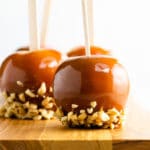Homemade Caramel Apples
The careful (but relatively easy, promise!) ingredient ratios and cooking method make the caramel on these apples just right. It's flavorful without tipping over into bitterness, and soft enough without being unmanageable. Isn't it fun when science makes things taste great? If you're new to caramel-making, refer to the step-by-step photos and the video for visual cues.
Servings: 8
Calories: 309kcal
Ingredients
- 8 small apples refrigerated
- ½ cup water
- 1 cup plus two tablespoons (225 grams) sugar
- ½ teaspoon fine sea salt
- 1 cup (237 ml) (225 grams) heavy cream
- ½ cup chopped salted peanuts
Instructions
- Wash and dry the apples very well. (See notes below.)
- Pull the stems out of the apples and insert one end of a popsicle stick, caramel apple stick, or twig into the stem end, about halfway into the apple, depending on size. You want to leave enough of the stick available for gripping while also ensuring it's firmly in place. Return the apples to the fridge until ready to dip.
- Line a baking sheet with a silicone mat (preferred) or with parchment paper sprayed with nonstick cooking spray, and set aside. If spraying with cooking spray, do NOT place the apples on this surface before coating with caramel.
- Spread chopped peanuts on a plate and set aside.
- Place the water, sugar, and salt into an impeccably clean 3- to 4-quart pot with a heavy bottom. Bring to a boil over medium heat, stirring constantly with a wooden spoon or heat-safe spatula until the sugar dissolves completely.
- When the mixture boils, stop stirring. Simmer undisturbed until sugar syrup takes on an amber color, about 10 minutes. (For a long time the mixture will be clear, and you'll see the bubbles gradually get bigger. Once it starts to take on some color, the rest happens fairly quickly.)
- As soon as the syrup is a nice, medium-dark amber, carefully pour in the cream. The mixture will boil up furiously. Stir vigorously with a wooden spoon or heatproof spatula. Continue cooking, stirring from time to time, until the caramel reaches 250°F (121°C).
- At this stage you can choose whether to leave the caramel in the pot or pour it into a 2-cup heatproof glass measuring cup. Let the caramel cool to about 212°F (100°C).
- One at a time, hold each apple by the stick and swirl to coat in the caramel. Let excess caramel drip back into the cup or pot. The caramel will cool quickly, so work as fast as you reasonably can. Place each apple on the prepared baking sheet. See notes below about reheating if necessary.
- Roll the base of each caramel-coated apple in chopped nuts. Set each apple back on the baking sheet to cool completely.
Notes
- You will need an instant-read thermometer or a candy thermometer.
- I prefer crisp, tart Granny Smith apples for this recipe, because their flavor and texture provide perfect counterpoints for the sweet, sticky caramel. But you can use any small apples that you like. (As you can see from the photos and video, I don't always use Granny Smith! These were some diminutive Honeycrisps that we had on hand.)
- It is VERY important that you wash the apples well (or buy unwaxed apples if you can find them at a farm or farmers' market) and dry them completely. Most apples sold in the US these days have a wax coating that will prevent the caramel from sticking. You can wash them well in very hot water (I usually do this and use a dab of dish soap for good measure, then rinse extremely well), or you can plunge each apple into boiling water for 5 seconds and then rinse very well (I find this to be more of a pain, so I don't usually do it this way).
- Salt choice is important here. Don't use table salt, because it can contain impurities that will cause your caramel to seize or become grainy. Fine sea salt works well, and the usual brands of Kosher salt should be fine, too.
- A 3- to 4-quart pot will seem large, but it's necessary because the caramel will bubble up furiously when you add the cream.
- Using a big pot should keep you safe, but it's also a smart idea to keep a little bowl of ice water on hand when working with boiling-hot sugar. If you happen to graze a fingertip or two into the heat, you can quickly plunge it into the water to cool it quickly.
- In the video, I've used a dark-colored pot (long story), but that's not the best choice, especially for beginners. If possible, use a stainless steel pot without a dark finish. The heavy bottom will help cook the caramel evenly, and the light color of the pot will make it much easier to judge the color of the caramel as it cooks during the first stage.
- I prefer to pour the caramel into a 2-cup heatproof glass measuring cup to cool. I find this shape and depth makes it easiest to coat the apples, and the glass can be microwaved if you need to reheat the caramel.
- The caramel will cool quickly as you dip the cold apples into it. If it gets too cool before you're finished dipping, you can rewarm it gently in the microwave or on the stovetop.
- Apples are best on the day they're made — but, once completely cooled, can be stored in an airtight container at room temperature for a day or two.
Nutrition
Calories: 309kcal | Carbohydrates: 56.2g | Protein: 3.7g | Fat: 9.8g | Fiber: 4.6g
